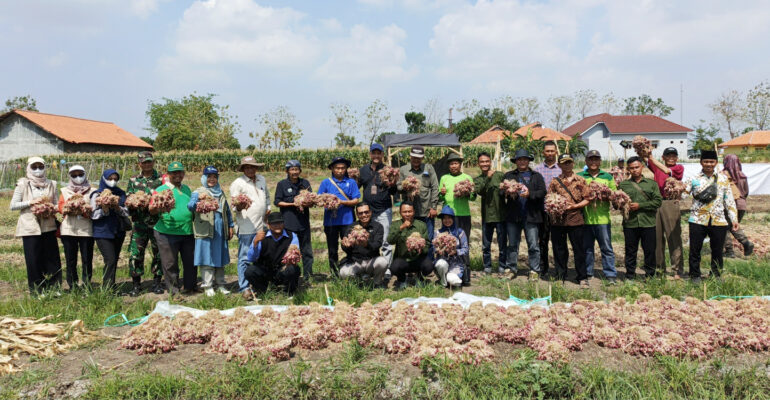IPB University Technology Boosts Shallot Productivity by 26 Percent Without Using Pesticides

IPB University, in collaboration with the Directorate of Horticultural Protection (Ditlin) at the Ministry of Agriculture, has introduced an intensive microbial technology for shallot cultivation. This initiative was implemented in two major shallot production centers, Brebes in Central Java and Nganjuk in East Java, as part of the Kedaireka 2024 Matching Fund Program.
During a communal harvest held at the demonstration plot in Pedeslohor Village, Jatibarang District, Brebes (2/11), the application of this technology produced impressive results, increasing shallot productivity by 26 percent without the use of pesticides.
“The results presented by farmers in the demonstration plot show that this technology improves seed germination uniformity, leaf count, bulb weight per plant, and overall productivity per area. Productivity, measured by wet bulb weight, increased by 26 percent,” stated Prof Widodo, leader of the research team.
Shallots are known for their high reliance on synthetic chemical pesticides, often sprayed every two days. Prof Widodo emphasized that this technology promotes plant growth, suppresses pest and disease attacks, and enhances productivity.
“This IPB University technology is more effective than conventional methods that rely on synthetic pesticides. Its distinct advantage is zero pesticide use, relying solely on natural and biological materials, while still achieving high productivity,” he explained.
Prof Suryo Wiyono, Dean of IPB University’s Faculty of Agriculture, noted, “Through the Faculty of Agriculture and the Center for Tropical Horticultural Studies (PKHT), IPB University has developed various technologies for shallot cultivation.”
“Since 2010, IPB University has been working on technology development using beneficial and selective microbes that have been tested across multiple crops,” he added.
He highlighted that the intensively designed microbial-based Integrated Pest Management (IPM) technology is highly effective, cost-efficient, and eco-friendly. This technology not only boosts productivity but also enhances efficiency.
Seeing the results in the demonstration plot, Juwari, a leading shallot farmer in Brebes, expressed optimism about the technology’s potential for broader application in shallot cultivation. Meanwhile, Makmur, a young farmer, hoped the technology could also benefit the cultivation of food crops and plantations.
Dwi Prasetio, a Ditlin Horti representative present at the event, expressed hope that, in addition to boosting quantity, the technology would improve quality by reducing pesticide residue in shallots, making them safer for consumption.
Ir Tanti Palupi, Chief of the Horticulture and Plantation Division in Brebes Regency, also shared her hopes. “Plant pest organisms (OPT) and soil fertility issues are ongoing challenges. This research is very helpful as it ensures that shallot production centers are not affected by OPT issues,” she remarked. (*/Rz) (IAAS/RUM)



